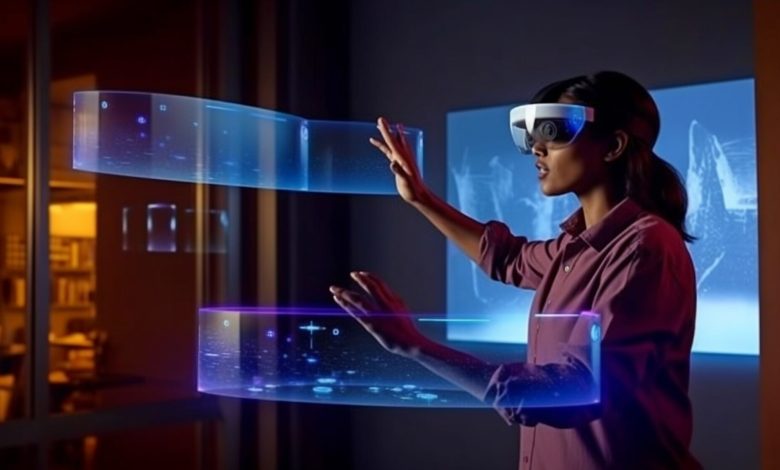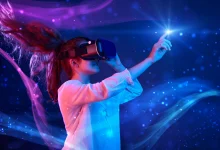Augmented Reality: Bridging the Gap Between Reality and Virtuality
Bridging the Gap Between Reality and Virtuality

Introduction:
In the realm of technological innovation, augmented reality (AR) stands as a groundbreaking frontier that seamlessly blends the physical world with digital elements, enhancing our perception and interaction with reality. AR technology overlays computer-generated images, sounds, or other content onto our view of the real world, creating immersive and interactive experiences that have the potential to revolutionize numerous industries, including gaming, education, healthcare, and more. This article delves into the fascinating world of augmented reality, exploring its origins, applications, and future possibilities.
Origins of Augmented Reality:
The concept of augmented reality traces its roots back to the 1960s and 1970s, when pioneering researchers and technologists began exploring ways to enhance human perception and interaction with computer-generated content. Early experiments in AR focused on head-mounted displays and interactive graphics systems, laying the groundwork for the development of more advanced AR technologies in the years to come. One notable early example of AR was the “Sword of Damocles,” a head-mounted display system developed by computer scientist Ivan Sutherland in 1968.
Origins of Augmented Reality in Gaming: A Journey from Concept to Innovation:
The origins of augmented reality (AR) in gaming can be traced back to the intersection of technology, creativity, and the desire to enhance the gaming experience with elements from the real world. While AR gaming has surged in popularity in recent years with the advent of smartphones and advanced computing devices, its roots can be found in the early experiments and innovations of pioneering developers and researchers. This article explores the fascinating origins of augmented reality in gaming, tracing its evolution from conceptual beginnings to the groundbreaking innovations of today.
Early Experiments and Concepts:
The seeds of augmented reality in gaming were planted in the early days of computer graphics and interactive entertainment. In the 1960s and 1970s, researchers and technologists began exploring ways to overlay computer-generated images onto the real world to enhance human perception and interaction. Early experiments, such as Ivan Sutherland’s “Sword of Damocles” and Myron Krueger’s “Videoplace,” laid the groundwork for the development of AR technology by demonstrating the potential for immersive and interactive experiences that blend the physical and digital worlds.
AR in Arcade and Theme Park Attractions:
In the 1990s and early 2000s, augmented reality made its first forays into the realm of gaming with arcade and theme park attractions that incorporated AR elements. Games like “Virtuality” and “Laser Tag” introduced players to interactive experiences that combined physical movement with digital overlays, creating immersive and engaging gameplay experiences that captivated audiences. Theme park attractions like Disney’s “Magic Kingdom” and Universal Studios’ “Jurassic Park: The Ride” also experimented with AR technology to enhance the theme park experience and immerse visitors in virtual worlds.
Handheld AR Devices and Early Mobile Experiments:
The rise of handheld computing devices and mobile technology in the late 2000s paved the way for a new wave of AR gaming experiences. Early experiments like the Nintendo 3DS’s “AR Games” and Sony’s PlayStation Vita’s “Reality Fighters” introduced players to handheld AR gaming, allowing them to interact with virtual characters and objects overlaid onto their real-world surroundings. These early experiments laid the groundwork for the development of more sophisticated AR gaming experiences on smartphones and tablets, which would soon revolutionize the gaming industry.
Smartphones and the AR Revolution:
The advent of smartphones equipped with cameras, GPS, and motion sensors ushered in a new era of AR gaming, transforming the way we play, interact, and experience games. Games like “Ingress” and “Pokémon GO” introduced millions of players to the concept of location-based AR gaming, allowing them to explore their real-world surroundings and interact with virtual objects and creatures overlaid onto their environment. These groundbreaking games demonstrated the potential for AR technology to create immersive and engaging gaming experiences that blur the lines between the physical and digital worlds.
Conclusion: The Future of AR Gaming:
As technology continues to evolve and improve, the future of augmented reality in gaming looks brighter than ever. With advancements in hardware, software, and platform support, AR gaming has the potential to revolutionize the way we play and experience games, offering endless
opportunities for creativity, innovation, and exploration. From immersive narrative adventures to location-based multiplayer experiences, AR gaming promises to transport players to new worlds and unlock new dimensions of gameplay and interactivity. As we continue to push the boundaries of what is possible with augmented reality, the only limit to the future of AR gaming is our imagination.
Advancements in AR Technology:
In the decades that followed, advancements in computer hardware, software, and mobile technology propelled augmented reality into the mainstream. The advent of smartphones and tablets equipped with cameras, GPS, and motion sensors provided developers with powerful platforms to create AR experiences that could be accessed by millions of users around the world. Companies like Google, Apple, and Microsoft invested heavily in AR research and development, leading to the creation of AR software development kits (SDKs) and frameworks that enabled developers to build immersive AR applications and games.
Advancements in AR Technology in Gaming: Shaping the Future of Interactive Entertainment
Augmented reality (AR) technology has undergone remarkable advancements in recent years, reshaping the landscape of gaming and offering players new ways to interact with digital content in the real world. From immersive experiences that blend virtual and physical elements to innovative gameplay mechanics that leverage the capabilities of AR devices, the evolution of AR technology has opened up exciting possibilities for developers and players alike. This article explores the groundbreaking advancements in AR technology within the gaming industry, highlighting key developments, trends, and their impact on the future of interactive entertainment.
Hardware Innovations:
Advancements in hardware have played a significant role in driving the evolution of AR technology in gaming. Early AR experiences relied on specialized headsets or cumbersome equipment, but recent innovations have made AR more accessible and user-friendly. Smartphones and tablets equipped with high-resolution cameras, powerful processors, and advanced sensors serve as the primary platforms for AR gaming, allowing players to experience immersive AR experiences without the need for additional hardware. Moreover, dedicated AR devices like AR glasses and headsets have also seen significant improvements in recent years. Companies like Microsoft, Magic Leap, and Google have developed AR glasses that offer immersive visuals, spatial awareness, and hands-free interaction, opening up new possibilities for AR gaming experiences. As these devices continue to evolve and become more affordable, they are likely to play a central role in the future of AR gaming.
Software Developments:
On the software front, advancements in AR development tools and platforms have empowered developers to create more sophisticated and immersive gaming experiences. Software development kits (SDKs) provided by companies like Apple (ARKit) and Google (ARCore) offer developers access to powerful AR capabilities, including motion tracking, environmental understanding, and light estimation, enabling them to create AR games with realistic interactions and seamless integration into the real world. In addition to SDKs, game engines like Unity and Unreal Engine have integrated AR features and functionality, making it easier for developers to incorporate AR elements into their games. These tools provide developers with a wide range of resources, including pre-built assets, templates, and tutorials, to streamline the AR development process and accelerate innovation in AR gaming.
Innovative Gameplay Mechanics:
Advancements in AR technology have also led to the emergence of innovative gameplay mechanics that leverage the unique capabilities of AR devices. Location-based AR games like “Pokémon GO” and “Harry Potter: Wizards Unite” use GPS and real-world maps to create immersive gaming experiences that encourage players to explore their surroundings and interact with virtual objects and characters. These games blend the physical and digital worlds, encouraging social interaction and exploration while offering players a new way to experience familiar locations. Furthermore, advancements in computer vision and object recognition have enabled developers to create AR games that recognize and interact with real-world objects. Games like “Minecraft Earth” and “IKEA Place” allow players to place virtual objects in their real-world environment and interact with them using gestures and touch controls. These experiences enhance immersion and creativity, empowering players to personalize their gaming experiences and interact with the world around them in new and exciting ways.
Future Directions:
Looking ahead, the future of AR technology in gaming holds tremendous promise for further innovation and growth. As hardware becomes more powerful and affordable, and software tools become more accessible and sophisticated, we can expect to see a proliferation of AR gaming experiences that push the boundaries of what is possible. From immersive narrative adventures to social multiplayer experiences and educational applications, AR gaming has the potential to transform how we play, learn, and interact with digital content in the real world. In conclusion, advancements in AR technology have paved the way for a new era of interactive entertainment, offering players unprecedented opportunities to engage with digital content in immersive and meaningful ways. As AR continues to evolve and mature, the gaming industry is poised to benefit from the creativity, innovation, and limitless potential that AR technology has to offer. With exciting advancements on the horizon, the future of AR gaming looks brighter than ever, promising new experiences, new challenges, and new adventures for players around the world.
Applications of Augmented Reality:
Augmented reality has found applications across a wide range of industries, from entertainment and gaming to education, healthcare, and beyond. In the realm of entertainment, AR gaming experiences like “Pokémon GO” and “Harry Potter: Wizards Unite” have captivated millions of players worldwide, allowing them to explore virtual worlds and interact with digital creatures overlaid onto their real-world surroundings. In education, AR technology has been used to create immersive learning experiences that bring history, science, and art to life, allowing students to visualize complex concepts and interact with virtual objects in a hands-on way.
Applications of Augmented Reality: Transforming Industries and Enhancing Experiences:
Augmented reality (AR) technology has transcended its roots in gaming to find applications across a diverse range of industries, revolutionizing the way we work, learn, communicate, and interact with the world around us. From immersive marketing experiences and innovative retail solutions to transformative healthcare interventions and cutting-edge industrial applications, AR has emerged as a powerful tool for enhancing productivity, engagement, and creativity. This article explores the wide-ranging applications of augmented reality, highlighting its impact on various sectors and its potential to shape the future of human-computer interaction.
Retail and Marketing:
In the retail and marketing sectors, augmented reality offers a multitude of opportunities for enhancing customer engagement and driving sales. Retailers can leverage AR technology to create immersive shopping experiences, allowing customers to visualize products in their own space before making a purchase. AR-powered try-on solutions for clothing and accessories enable customers to virtually try on items, reducing the need for physical dressing rooms and enhancing the online shopping experience. Additionally, AR marketing campaigns and interactive advertisements captivate audiences with engaging content and interactive experiences, increasing brand awareness and driving consumer engagement.
Education and Training:
Augmented reality has the potential to revolutionize education and training by providing immersive and interactive learning experiences. In the classroom, AR technology can bring educational concepts to life, allowing students to visualize complex ideas in three-dimensional space and interact with virtual models and simulations. AR-enabled textbooks and educational apps enhance learning retention and engagement by providing interactive content and real-time feedback. Furthermore, AR-based training solutions empower employees to acquire new skills and knowledge in a hands-on, experiential manner, reducing training costs and improving performance outcomes across various industries.
Healthcare and Medicine:
In healthcare and medicine, augmented reality is transforming patient care, medical training, and surgical procedures. AR technology enables doctors and surgeons to visualize patient data, medical images, and diagnostic information in real time, enhancing clinical decision-making and improving patient outcomes. Surgical navigation systems equipped with AR displays provide surgeons with enhanced visualization and guidance during complex procedures, reducing errors and improving surgical precision. Additionally, AR-based medical education and training tools simulate realistic medical scenarios and procedures, allowing students and healthcare professionals to practice and refine their skills in a safe and controlled environment.
Industrial and Manufacturing:
Augmented reality is revolutionizing industrial and manufacturing processes by providing workers with real-time information, guidance, and visualization tools. AR-powered maintenance and repair solutions enable technicians to access digital manuals, schematics, and instructional videos overlaid onto their physical environment, increasing efficiency and reducing downtime. In manufacturing, AR technology facilitates product design, prototyping, and assembly by providing engineers and technicians with interactive 3D models and virtual simulations. Furthermore, AR-based quality control and inspection systems detect defects and anomalies in real time, ensuring product quality and consistency throughout the production process.
Entertainment and Tourism:
In the entertainment and tourism industries, augmented reality offers immersive and interactive experiences that engage audiences and enhance visitor engagement. AR-powered attractions and exhibits provide visitors with interactive storytelling experiences, allowing them to explore historical sites, museums, and cultural landmarks in a dynamic and engaging manner. AR-enhanced tour guides and navigation apps offer personalized recommendations and information based on users’ interests and preferences, enriching their travel experiences and fostering deeper connections with local culture and heritage.
Conclusion: Shaping the Future of Human-Computer Interaction:
In conclusion, the applications of augmented reality are as diverse as they are transformative, offering innovative solutions to complex challenges and unlocking new possibilities for human-computer interaction. As AR technology continues to evolve and mature, its impact will extend across virtually every aspect of our lives, from education and healthcare to retail and entertainment. By harnessing the power of augmented reality, organizations and industries can create immersive, engaging, and meaningful experiences that enhance productivity, creativity, and quality of life for people around the world. With its vast potential and boundless opportunities, augmented reality is poised to shape the future of human-computer interaction in profound and exciting ways.
Future Possibilities and Potential:
Looking ahead, the future of augmented reality holds limitless possibilities for innovation and discovery. As AR technology continues to evolve and improve, we can expect to see even more immersive and interactive experiences that blur the lines between the physical and digital worlds. From augmented reality glasses and contact lenses to augmented reality smart mirrors and holographic displays, the next generation of AR devices promises to revolutionize the way we work, play, and interact with the world around us.
Future Possibilities and Potential of Augmented Reality: Pioneering a New Era of Interaction:
As augmented reality (AR) technology continues to evolve and mature, its future possibilities and potential are boundless, promising to reshape the way we live, work, and interact with the world around us. From revolutionizing industries and transforming everyday tasks to unlocking new creative possibilities and enhancing human capabilities, AR is poised to pioneer a new era of interaction and innovation. This article explores the exciting future of augmented reality, highlighting key trends, advancements, and opportunities that lie ahead.
Enhanced User Experiences:
One of the most promising aspects of AR technology is its ability to enhance user experiences across various domains. In the realm of entertainment, AR will continue to revolutionize gaming, providing players with immersive, interactive, and location-based experiences that blur the lines between the digital and physical worlds. In retail, AR will enable customers to visualize products in real-world environments, try on virtual clothing and accessories, and make more informed purchasing decisions. Similarly, in education and training, AR will offer students and professionals immersive learning experiences that foster engagement, retention, and skill development.
Spatial Computing and Wearable Devices:
The future of AR will be shaped by advancements in spatial computing and wearable devices that seamlessly integrate digital content into the physical world. AR glasses and headsets will become lighter, more comfortable, and more powerful, offering users immersive visual overlays, spatial audio, and intuitive gesture-based controls. These wearable devices will serve as personalized portals to the augmented world, providing users with real-time information, context-aware assistance, and personalized experiences tailored to their preferences and needs.
Enterprise Applications and Productivity Tools:
In the enterprise sector, AR will revolutionize workflows, processes, and collaboration, enabling organizations to streamline operations, improve productivity, and drive innovation. AR-powered remote assistance solutions will connect workers in different locations, allowing them to share knowledge, troubleshoot issues, and collaborate on tasks in real time. In manufacturing and logistics, AR will enhance training, maintenance, and quality control processes, empowering workers with digital overlays, guided instructions, and contextual information to optimize performance and reduce errors.
Healthcare and Telemedicine:
Augmented reality holds tremendous promise for transforming healthcare and telemedicine, offering innovative solutions for patient care, medical education, and surgical procedures. AR-enabled medical imaging systems will provide doctors and surgeons with enhanced visualization and diagnostic capabilities, improving treatment outcomes and patient safety. Telemedicine platforms equipped with AR technology will enable remote consultations, virtual examinations, and remote monitoring, expanding access to healthcare services and improving the efficiency of healthcare delivery.
Creative Expression and Digital Art:
As AR technology becomes more accessible and intuitive, it will unlock new creative possibilities for artists, designers, and content creators. AR-enabled tools and platforms will allow creators to design interactive installations, immersive experiences, and digital art pieces that transcend traditional mediums and engage audiences in new and compelling ways. AR art galleries, museums, and exhibitions will offer visitors immersive, multisensory experiences that blur the boundaries between physical and digital art forms, democratizing access to art and fostering creativity and expression.
Conclusion: Shaping the Future of Interaction:
In conclusion, the future of augmented reality is filled with endless possibilities and potential, offering transformative solutions to complex challenges and unlocking new opportunities for innovation and creativity. From enhancing user experiences and productivity to revolutionizing industries and transforming healthcare, AR technology has the power to shape the way we interact with the world and each other. By embracing the opportunities presented by augmented reality and leveraging its capabilities to solve real-world problems, we can pave the way for a future where augmented reality becomes an integral part of our everyday lives, empowering us to explore, create, and connect in ways we never thought possible.
Challenges and Considerations:
Despite its tremendous potential, augmented reality also faces a number of challenges and considerations, including privacy concerns, technical limitations, and societal implications. Issues such as data privacy, digital ethics, and user safety must be carefully considered as AR technology becomes more pervasive and integrated into our daily lives. Additionally, ensuring accessibility and inclusivity in AR experiences will be essential to ensuring that everyone can benefit from the transformative power of augmented reality.
Conclusion: A New Era of Augmented Reality:
In conclusion, augmented reality represents a new era of technological innovation that has the potential to fundamentally transform the way we perceive and interact with the world around us. From immersive gaming experiences to practical applications in education, healthcare, and beyond, AR technology offers endless opportunities for creativity, exploration, and discovery. As we continue to push the boundaries of what is possible with augmented reality, we must also remain mindful of the ethical, societal, and environmental implications of this powerful technology, ensuring that it serves to enhance our lives and enrich our collective human experience.
Introduction to Augmented Reality:
As technology continues to advance at an unprecedented pace, we find ourselves on the cusp of a new era of immersive experiences. Augmented Reality (AR) has emerged as a groundbreaking technology that seamlessly merges the digital world with the physical world, enhancing our perception of reality. By overlaying computer-generated content onto our real-world environment, AR has the potential to revolutionize various industries and transform the way we interact with the world around us.
The History of Augmented Reality
While the concept of augmented reality may seem like a recent development, its roots can be traced back several decades. The term “augmented reality” was first coined by Tom Caudell, a researcher at Boeing, in the early 1990s. However, the origins of AR can be traced back even further to Ivan Sutherland’s “Sword of Damocles,” a head-mounted display system developed in the late 1960s. Since then, AR has evolved significantly, with advancements in hardware and software enabling more immersive and realistic experiences.
Applications of Augmented Reality in Various Industries
The applications of augmented reality are vast and diverse, spanning across numerous industries. One such industry is architecture and design, where AR is revolutionizing the way architects visualize their creations. By superimposing virtual models onto real-world environments, architects can gain a better understanding of how their designs will interact with the surrounding space. Similarly, the retail industry is leveraging AR to offer customers interactive and personalized shopping experiences. Through AR-enabled apps, customers can virtually try on clothes, accessories, and even visualize furniture in their own homes.
The Impact of Augmented Reality on User Experiences
Augmented reality has the power to significantly enhance user experiences by providing a more immersive and interactive environment. In the realm of entertainment and gaming, AR has already made a profound impact. Games like “Pokémon Go” have taken the world by storm, allowing players to catch virtual creatures in their real-world surroundings. This blend of virtual and physical elements creates a unique and engaging experience that captivates users. Moreover, AR has the potential to transform education and training by providing interactive and immersive learning experiences. Students can explore historical landmarks, dissect virtual organisms, and conduct scientific experiments, all within the confines of a classroom.
The Future of Augmented Reality Technology
As technology continues to advance, the future of augmented reality looks promising. With the advent of 5G networks, AR experiences will become more seamless and responsive, allowing for real-time interactions and collaboration. Additionally, advancements in wearable technology, such as smart glasses, will make AR more accessible and integrated into our daily lives. Imagine walking down the street, and through your smart glasses, you can see real-time information about nearby restaurants, stores, and even receive personalized recommendations.
Challenges and Limitations of Augmented Reality
While the potential of augmented reality is immense, it is not without its challenges and limitations. One of the major challenges is the need for robust and accurate tracking systems to ensure virtual objects align correctly with the real-world environment. Additionally, the development of high-quality content and applications for AR remains a challenge, requiring a skilled workforce and significant investment. Furthermore, privacy and security concerns arise as AR technology becomes more pervasive, raising questions about data collection and user consent.
Augmented Reality in Gaming and Entertainment
The gaming and entertainment industry has been at the forefront of embracing augmented reality. Games like “Pokémon Go” have demonstrated the immense popularity and potential of AR gaming. Beyond gaming, AR is also being utilized in theme parks and live events to create immersive and interactive experiences. Imagine attending a concert where virtual characters and objects come to life, enhancing the overall entertainment value.
Augmented Reality in Education and Training
In the field of education and training, augmented reality is transforming traditional learning methods. AR allows students to engage with educational content in a more interactive and hands-on manner. For example, medical students can practice surgical procedures in a virtual environment, allowing them to gain valuable experience before performing actual surgeries. AR also has the potential to bridge the gap between theoretical knowledge and practical application, making learning more engaging and effective.
Augmented Reality in Healthcare and Medicine
Augmented reality is making significant strides in the healthcare and medical field. Surgeons can now use AR to overlay virtual images onto a patient’s body during surgeries, providing real-time guidance and improving precision. AR is also being utilized in medical training to simulate complex procedures and enhance medical education. Furthermore, AR has the potential to improve patient outcomes by providing personalized healthcare experiences and empowering patients to actively participate in their treatment plans.
Conclusion:
The Transformative Potential of Augmented Reality:
As we delve deeper into the world of augmented reality, the possibilities for immersive experiences seem limitless. From enhancing entertainment and gaming to revolutionizing education, healthcare, and beyond, AR has the power to reshape the way we interact with the world. However, as with any emerging technology, there are challenges to overcome, including technological limitations, content development, and ethical considerations. Nonetheless, the transformative potential of augmented reality is undeniable, and as we continue to push the boundaries of what is possible, we can look forward to a future where the line between the real and the virtual becomes increasingly blurred.











